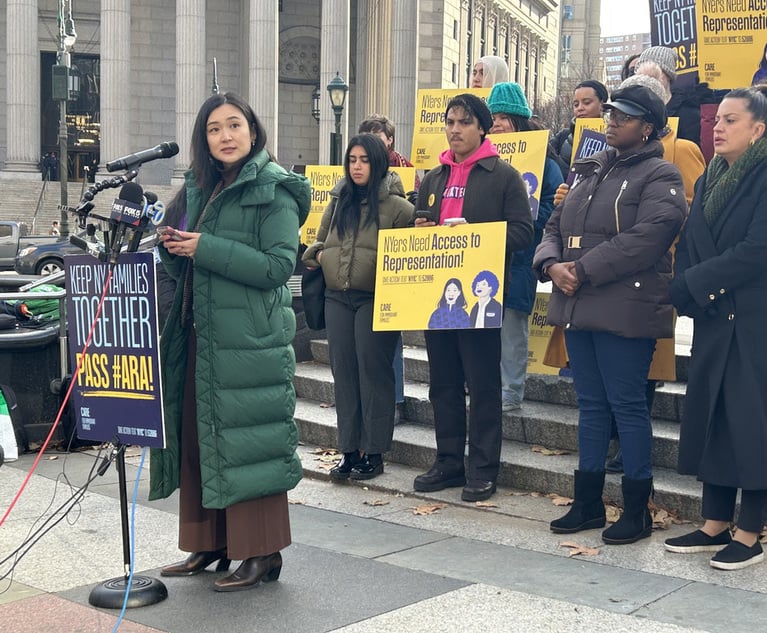Study Finds Bail Reforms Would Have Released 20,000 People From Jail in 2018
The hypothetical finding about how bail reform would affect 2018 cases falls in line with Gov. Andrew Cuomo's assessment of the bill's effect back in March.
September 10, 2019 at 05:52 PM
2 minute read
 A bail bonds agency. Photo: Paul Brady/Shutterstock
A bail bonds agency. Photo: Paul Brady/Shutterstock
Nearly 20,000 more people would have been released from jail without bail before trial in 2018 if New York's statewide bail reforms had been in place then, according to a study published Monday by John Jay College's Data Collaborative for Justice.
Using New York City Office of Court Administration data, the John Jay researchers found that release without bail would have been required in 90% of 2018 cases if bail reform were in place at that time. In reality, people charged but not convicted of crimes in 2018 were released without bail in 76% of the cases that continued beyond arraignment, researchers reported.
The hypothetical finding about how bail reform would affect 2018 cases falls in line with Gov. Andrew Cuomo's assessment of the bill's effect back in March.
"Ninety percent of the people who are charged will remain out of jail," he told reporters around the time the bill was passed. Cash bail will remain an option for most violent felonies and in a few other situations, while police will be required to issue appearance tickets rather than making arrests in most low-level cases.
Researchers cautioned that the analysis should not be seen as a projection for what will happen when the law goes into effect in 2020. Projecting the effects of bail reform is especially challenging, they said, because it was passed alongside several other key criminal justice reforms, including changes to criminal discovery and how quickly criminal trials move.
The study, which only examined New York City data, broke down the analysis by borough. Manhattan would have been most affected if bail reform existed in 2018, with an additional 19% of cases leading to release without bail compared to Brooklyn's 11%, researchers found.
Prosecutors, including Manhattan District Attorney Cy Vance, have objected to the changes. Through a spokesperson, Vance declined to comment on the John Jay study, but he has criticized the expected costs of the reforms and potential risks to public safety posed by the widespread releases.
The Data Collaborative for Justice is continuing to study the potential effects of the criminal justice reform bill and will examine its actual effects starting in January, researchers said.
This content has been archived. It is available through our partners, LexisNexis® and Bloomberg Law.
To view this content, please continue to their sites.
Not a Lexis Subscriber?
Subscribe Now
Not a Bloomberg Law Subscriber?
Subscribe Now
NOT FOR REPRINT
© 2025 ALM Global, LLC, All Rights Reserved. Request academic re-use from www.copyright.com. All other uses, submit a request to [email protected]. For more information visit Asset & Logo Licensing.
You Might Like
View All
So Who Won? Congestion Pricing Ruling Leaves Both Sides Claiming Victory, Attorneys Seeking Clarification
4 minute read
Hochul Vetoes 'Grieving Families' Bill, Faulting a Lack of Changes to Suit Her Concerns

Court System Names New Administrative Judges for New York City Courts in Leadership Shakeup
3 minute read
Trending Stories
Who Got The Work
J. Brugh Lower of Gibbons has entered an appearance for industrial equipment supplier Devco Corporation in a pending trademark infringement lawsuit. The suit, accusing the defendant of selling knock-off Graco products, was filed Dec. 18 in New Jersey District Court by Rivkin Radler on behalf of Graco Inc. and Graco Minnesota. The case, assigned to U.S. District Judge Zahid N. Quraishi, is 3:24-cv-11294, Graco Inc. et al v. Devco Corporation.
Who Got The Work
Rebecca Maller-Stein and Kent A. Yalowitz of Arnold & Porter Kaye Scholer have entered their appearances for Hanaco Venture Capital and its executives, Lior Prosor and David Frankel, in a pending securities lawsuit. The action, filed on Dec. 24 in New York Southern District Court by Zell, Aron & Co. on behalf of Goldeneye Advisors, accuses the defendants of negligently and fraudulently managing the plaintiff's $1 million investment. The case, assigned to U.S. District Judge Vernon S. Broderick, is 1:24-cv-09918, Goldeneye Advisors, LLC v. Hanaco Venture Capital, Ltd. et al.
Who Got The Work
Attorneys from A&O Shearman has stepped in as defense counsel for Toronto-Dominion Bank and other defendants in a pending securities class action. The suit, filed Dec. 11 in New York Southern District Court by Bleichmar Fonti & Auld, accuses the defendants of concealing the bank's 'pervasive' deficiencies in regards to its compliance with the Bank Secrecy Act and the quality of its anti-money laundering controls. The case, assigned to U.S. District Judge Arun Subramanian, is 1:24-cv-09445, Gonzalez v. The Toronto-Dominion Bank et al.
Who Got The Work
Crown Castle International, a Pennsylvania company providing shared communications infrastructure, has turned to Luke D. Wolf of Gordon Rees Scully Mansukhani to fend off a pending breach-of-contract lawsuit. The court action, filed Nov. 25 in Michigan Eastern District Court by Hooper Hathaway PC on behalf of The Town Residences LLC, accuses Crown Castle of failing to transfer approximately $30,000 in utility payments from T-Mobile in breach of a roof-top lease and assignment agreement. The case, assigned to U.S. District Judge Susan K. Declercq, is 2:24-cv-13131, The Town Residences LLC v. T-Mobile US, Inc. et al.
Who Got The Work
Wilfred P. Coronato and Daniel M. Schwartz of McCarter & English have stepped in as defense counsel to Electrolux Home Products Inc. in a pending product liability lawsuit. The court action, filed Nov. 26 in New York Eastern District Court by Poulos Lopiccolo PC and Nagel Rice LLP on behalf of David Stern, alleges that the defendant's refrigerators’ drawers and shelving repeatedly break and fall apart within months after purchase. The case, assigned to U.S. District Judge Joan M. Azrack, is 2:24-cv-08204, Stern v. Electrolux Home Products, Inc.
Featured Firms
Law Offices of Gary Martin Hays & Associates, P.C.
(470) 294-1674
Law Offices of Mark E. Salomone
(857) 444-6468
Smith & Hassler
(713) 739-1250






